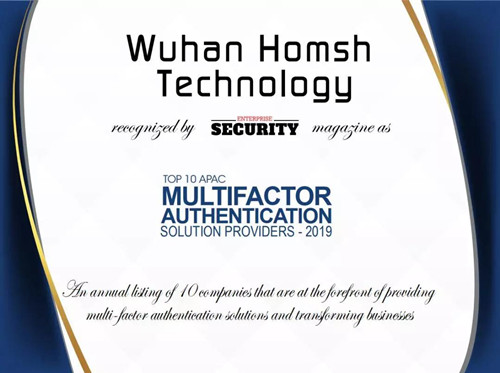Wuhan Homsh Technology Forging a Secure World with Innovative Iris Scans
2019-08-21
Enterprise Security Magazine :Even though some companies are spending billions of dollars on security products and services, the number of data breaches is increasing. As hackers become more sophisticated in their methods to take over sensitive accounts and steal critical information, enterprises must also improve their defenses. Leading organizations are recognizing this and are beginning to focus on better securing end-user identities.
Multi-factor authentication has evolved as the single most effective control to insulate an organization against remote attacks and when implemented correctly, can prevent most threat actors from easily gaining an initial foothold into your organization, even if credentials become compromised. Implementing multi-factor authentication across an organization’s Internet-facing assets is one of the most effective ways to prevent unauthorized access to sensitive data. As the workplace changes and more employees work outside the office, companies require more advanced multi factor authentication solutions to manage more complex access requests. With multi-factor authentication’s simple deployment and management as well as its integration with a broad range of applications, IT teams are freed up and can focus this time on more strategic tasks.
In this digital age, validating identities and controlling access is vital, which is why multi-factor authentication has become such a fundamental requirement in so many organizations. To help organizations select the best vendors, a distinguished panel comprising of prominent CEOs, CIOs, VCs, and analysts, along with Enterprise Security Magazine’s editorial board has assessed and shortlisted Multi-factor authentication solution providers that are at the forefront of providing cutting-edge technology solutions. We present to you “Top 10 Multi-Factor Authentication Solution Providers – 2019”.

One of the biggest concerns for any company with regard to information security is managing a users’ login on computers, servers, and high risk equipment terminals and authorizing data access. Even though the security market is inundated with several innovative authentication methods such as digital password, fingerprint identification, and face recognition, yet they are susceptible to vulnerabilities and can be easily breached. In contrast, iris scans are very difficult to duplicate and it is becoming the preferred authentication method for the government, enterprise, public, and finance information security. In order to maximize the potential of iris scanning technology and ensure its inevitable widespread application, Wuhan Homsh Technology has established a complete suite of iris recognition products, which guarantee secure authentication and cannot be circumvented. “With our iris biometric application-specific integrated chip, we aim to solve the challenging problems of high cost, high power consumption, difficult integration, and complexity associated with current iris scanning solutions,” says Yi Kaijun, general manager and CEO of Wuhan Homsh Technology.
The company’s iris recognition chip cuts costs by around 50-100 fold when compared to current software-based solutions as its power consumption is only 100 milliwatt, and unless damaged, it has the capability to run forever. Apart from being extremely stable, the computing ability of the iris chip is very powerful, which makes instant iris recognition possible. The company has launched its QianXin Q80 iris chip and built modules for various devices and typical applications such as iris locks. Besides Q80 chips for edge computing, Wuhan Homsh has developed K10, a powerful processor to perform high-speed iris data encoding and K20 for high-speed iris matching.
At the core of Wuhan Homsh’s iris recognition chips is its proprietary iris recognition algorithm, which took eight years of development efforts. The algorithm includes both generic static modules of segmentation, encoding, matching, and application-specific dynamic modules of image quality evaluation, real-time detection, and exposure control. The consideration of amplitude, phase difference, and similarity of iris images empowers the algorithm to accurately identify and recognize a person from millions or even billions. This accuracy also undoubtedly facilitates superior security. “What makes us second to none is the way we integrate our algorithm with other traditional devices like smartphones and locks or innovative devices like VRs at a low cost,” adds Kaijun.
Since every client has a unique requirement for security, Wuhan Homsh has designed a systematic merit table that is optimized for different applications, for instance, a smart home requires a much lower level of security than a public organization. As such, for smartphones, only one user is authorized, so the false acceptance rate (FAR) can be set as high as 10-5; for less than 10000 users the FAR can be set as10-6. Additionally, the company builds different applications and devices to fulfill specified requirements for various industries. Moving forward, Wuhan Homsh will continue to enhance its iris recognition technology to adapt to challenges such as long-distance recognition and multiple person identification. To achieve those goals, the company is further tuning its iris recognition algorithm and adding new capabilities such as multiple faces and iris tracking, multiple gaze iris capturing to name a few. Further, Wuhan Homsh intends to develop iris smartphones, smart watches, smart glasses, and smart VRs for the electronics industry. Along the path of geographical expansion, the company has targeted the South Asian and African region. The combination of Wuhan Homsh’s low cost, high-performance iris recognition chips and advanced algorithm has allowed the company to gain an edge over competitors.




